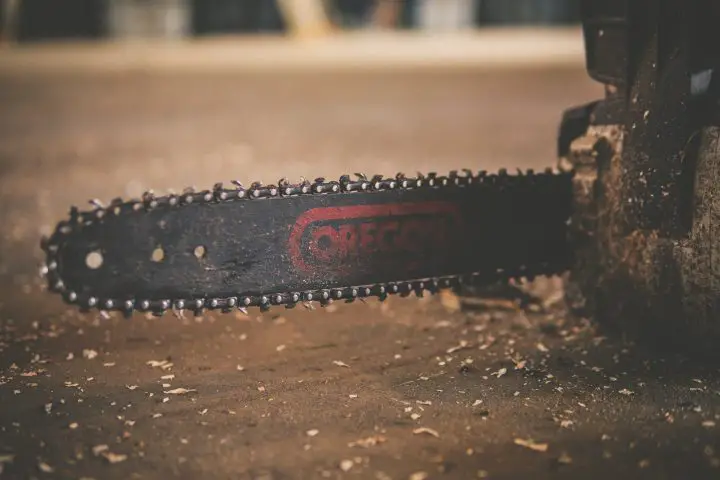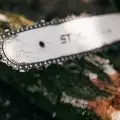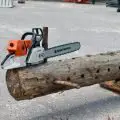There is a little “Goldilocks zone” when it comes to the ideal chainsaw chain tightening, where it is neither too loose nor too tight. Understanding chain tension can be a little challenging, especially if you’ve never changed it before. So why is it important to have the proper chain tension?
The chain on your chainsaw may fly off if it is too slack. A chain that flies off could result in anything from a minor inconvenience to a catastrophic injury. On the other hand, if your chain is excessively tight, it could harm (or ruin) your chainsaw by grinding out the motor.
The good news is that adjusting your chain is a fairly easy operation. In this article, you will learn how to adjust a chainsaw chain, how tight the chain should be, and how to check to see whether the adjustment is correct.
Table of Contents
- Why Is Chain Tightness Important?
- How Tight Should a Chainsaw Chain Be?
- How to Test the Tension of Your Chainsaw Chain
- What Tools Do I Need to Tighten a Chainsaw Chain?
- How Do I Tighten the Chainsaw Chain?
- FAQs (Frequently Asked Questions)

Why Is Chain Tightness Important?
Let’s discuss the benefits of having the chain correctly tightened before moving on. Let’s say you have a brand-new saw with a correctly tensioned chain to start. The chain will gradually sag as you use your saw due to it undergoing stress.
First of all, this might cause the blade to swerve as it cuts through the wood. Because of this, cutting is ineffective and uneven, and teeth deteriorate more quickly than they should. Additionally, it is rather hazardous that a slack chain can even fly out of the saw.
Why then don’t you simply tighten the chain as much as you can? In this manner, you can avoid having it come loose for even longer. While this may seem wise, an excessively tight chain has significant drawbacks of its own.
One consequence is that your blade won’t move as swiftly as it should because it puts additional strain on the motor. Additionally, the chain could snap under excessive strain, which would be considerably more dramatic and dangerous than losing a slack chain.
As you can see, being able to tighten your chainsaw chain to the proper degree is a crucial ability. By performing the task yourself rather than having your chain professionally tightened, you’ll save a ton of money, time, and effort, whether you’re using an electric or gas-powered chainsaw. Visit our Electric vs Gas Chainsaw guide to learn more about these types of chainsaws.
How Tight Should a Chainsaw Chain Be?
In a nutshell, your chainsaw chain needs to be “snap tight,” as pros would say. In essence, “snap tight” refers to the ability to raise your chain till the drive links are exposed but still secured to the guide bar. If your chain is in the proper position, pulling on it will cause it to “snap” back into place.
Don’t worry; I know this seems really theoretical. We’ve included a straightforward procedure for testing correct chainsaw chain tension below. But exactly how tight should the chain be? Check the interior of your chain to find out. You can see tiny teeth in the shape of shark fins there; they fit into the groove in the bar. You have a loose chain if those teeth can slip out of the groove.
Interested in learning about the various Types of Chainsaw Chains? Visit our article!
How to Test the Tension of Your Chainsaw Chain
There are two ways to gauge the correct tension in your chain:
1. The Snap Test
Pull your chain as far as it will go away from the bar to conduct a “snap test.” Release the chain after that. One of the best indicators of good tension is when something snaps back into place tightly. Your chain is too tight if you are unable to remove it from the bar. In contrast, if the chain simply goes limp when you take it away from the bar, it is too loose.
2. The Pull Test
This is the test most people employ frequently, as it is easy to understand and effective. Pull the chain away from the bar slowly to conduct the “pull test.” As far as you can comfortably pull while maintaining finger control of the chain, however, the drive links should not totally clear the bar groove. Instead, you want the chain to lift away from the bar in some places.
What Tools Do I Need to Tighten a Chainsaw Chain?
The majority of chainsaws will come with a tensioning tool for adjusting the chain. This hollow tube contains a hex socket at one end, acting as a handle. A normal screwdriver with a T-shaped blade protrudes from the handle. All you’ll need to adjust the chainsaw chain tension is one of these.
However, some manufacturers exclude tools, so you’ll need to purchase them separately. Another option is to use a ratchet set and a normal screwdriver that you already own. Finding the right socket and the nuts holding the bar cover in place will allow you to complete this task.
Here’s an example of a chainsaw chain tensioner available on Amazon that’s suitable for various Echo chainsaws:
- Package including Echo Part Number:V651000001 V651000011 V203000110 C309000030 V355000800
Prices pulled from the Amazon Product Advertising API on:
Product prices and availability are accurate as of the date/time indicated and are subject to change. Any price and availability information displayed on [relevant Amazon Site(s), as applicable] at the time of purchase will apply to the purchase of this product.
How Do I Tighten the Chainsaw Chain?
First of all, you must wait for your chainsaw to cool off if you’ve been using it. Both a hot chain and a hot saw have the potential to burn you until they cool. Before you begin adjusting, unplug the spark plug wire whether or not the saw is hot. The last thing you need while working is for the motor to start suddenly. If you have an electric saw, turn it off. If it runs on batteries, take the battery out.
Now, slightly loosen the nuts on the bar cover. As you tighten them, don’t go all the way because the bar can start to loosen. Yet you want it to be slack enough to allow the bar to slide back and forth without any restriction. The tension screw must now be located. Depending on the chainsaw you have, this may be in various locations. The majority of the time, it is in one of the following locations:
- Side panel – between the holding bolts for the guide bar.
- Front panel – it will be directly to the right of the guide bar and to the left of the bucking spikes if you’re facing the front of the chainsaw (if your chainsaw has them).
- Integrated tension system – There are now “easy-tension” systems built into many modern chainsaws. Instead of tightening the chain with a screw, this kind of chainsaw has an incorporated handle that you can move by hand to change tension.
In the event that it is not there, consult your owner’s manual.
First, hold the end of the bar so it is level and not sagging before tightening the chain. The bar will be forced outwards as the tension screw is tightened, tightening the chain. The chain will relax when you loosen the screw, and the tension on the bar will be released. All that’s left to do is retighten the bar cover nuts once the tension is just right. You’re all set! Your chain has been made more secure!
FAQs (Frequently Asked Questions)
How do I know if my chainsaw chain is tight enough?
A chainsaw’s exact tightness can be easily tested. You can use your fingertips to check it. Simply take hold of the chain, extend it as far as you can, and then let go. When it returns to its initial position after being released, it is sufficiently tight. If not, it must be slightly tightened further.
Can you over tighten a chainsaw chain?
Chainsaw chains can be overtightened yes. A chainsaw chain that has been overtightened runs the danger of breaking while in use. Proper chainsaw chain tension is imperative. The chain should have some play, but not enough for the drive links to separate from the guide bar.
Why does my chainsaw chain get loose so quickly?
The chain becomes extremely hot from the friction of cutting through wood, and the heat makes it loosen. The guide bar enlarges in the heat, and the chain stretches when it cools. The more you use your chainsaw, and the more it endures wear and tear, the more likely you’ll end up with a loose chainsaw chain.







